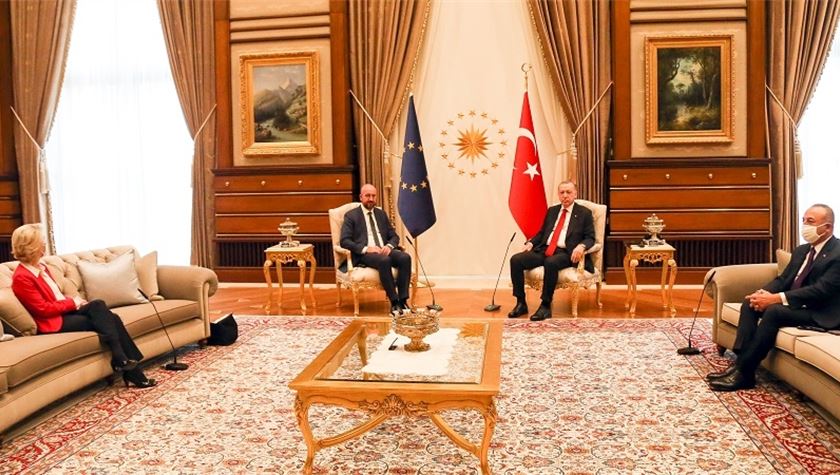

Nothing is more crucial in the life of a protocol officer than the order of precedence. Whether you’re meeting a state official, a member of the royal household, a colleague, or a friend, understanding and respecting precedence is key to smooth interactions and successful events. To illustrate this, I’ll use a notable diplomatic faux pas involving three presidents and two chairs to demonstrate the significance of precedence.
Many of you may have seen the headlines about the diplomatic faux pas where European Commission President Ursula von der Leyen was put in an awkward situation. In a meeting with Turkish President Erdogan and EU Council President Charles Michel, only two chairs were provided. President von der Leyen was seated on a sofa a little further away from her counterparts and opposite the Turkish foreign minister.

For some background, the EU stated that the protocol level of both their representatives is exactly the same. Therefore, President von der Leyen should have been seated in the same manner as both gentlemen. Turkey insisted that the EU’s protocol requests were applied, leading to a shaming and blame game.
For all official meetings, luncheons, or dinners, protocol officers determine the seating arrangements and prepare a seating plan. This usually involves coordination with the guest country or institution. The order of precedence is the protocol officer’s best friend and first consideration.
According to the official EU website, the order of precedence among EU dignitaries is as follows:
1. The President of the European Parliament
2. The President of the European Council (Mr. Charles Michel)
3. Members of the European Council, including the President of the European Commission (Ms. Ursula von der Leyen)
Based on this, President von der Leyen is lower in the order of precedence than her male counterpart. However, this situation also requires the application of experience, judgment, and common sense.
I like to think of the order of precedence as an art. The art of precedence is a far more intangible and subtle skill than just following a list. Sometimes, protocol officers need to make determinations based on a combination of intricate factors rather than a straightforward hierarchy. In this case, both EU representatives are the highest EU officials, which means that common sense and personal judgment should have been applied.
Imagine you’re the president of your country, and you have the president and the prime minister of another country visiting. Would you exclusively talk to the president because they hold the same position as you? Of course not. You would treat both with equal respect. Similarly, President von der Leyen should have been seated alongside both gentlemen to the left of Turkish President Erdogan.
To sum up, the order of precedence and sound judgment should be the major determinants of effective seating arrangements. Whether this incident was a genuine mistake or an intended discourtesy, the key takeaway is the importance of proper protocol that shows respect and recognition.
For more tips on the role and responsibilities of a protocol officer, check out my online resources. For personalized help, I’m also available for one-on-one coaching.
Are you ready to master the art of precedence and become a successful protocol officer? Enhance your skills and excel in the world of etiquette, good manners, and protocol today!
Take the first step towards improving your social and professional skills. Our free consultation will provide you with tailored advice and insights to help you achieve your goals. Don’t wait—book your session today and begin your transformation!
Kristina Szabova is a certified Etiquette Consultant and member of the International Association of Professional Etiquette Consultants.
Each book is packed with practical tips and expert advice. Perfect for those looking to refine their skills and elevate their everyday interactions.
Learn at your own pace with our online courses offer. Unlock your potential with expert-led training from the comfort of your home.
Achieve your goals with personalized one-on-one coaching. I’m here to support you every step of the way.
Shop our collection of stylish and functional products, including diaries, calendars, and tea sets.
| Cookie | Duration | Description |
|---|---|---|
| cookielawinfo-checkbox-analytics | 11 months | This cookie is set by GDPR Cookie Consent plugin. The cookie is used to store the user consent for the cookies in the category "Analytics". |
| cookielawinfo-checkbox-functional | 11 months | The cookie is set by GDPR cookie consent to record the user consent for the cookies in the category "Functional". |
| cookielawinfo-checkbox-necessary | 11 months | This cookie is set by GDPR Cookie Consent plugin. The cookies is used to store the user consent for the cookies in the category "Necessary". |
| cookielawinfo-checkbox-others | 11 months | This cookie is set by GDPR Cookie Consent plugin. The cookie is used to store the user consent for the cookies in the category "Other. |
| cookielawinfo-checkbox-performance | 11 months | This cookie is set by GDPR Cookie Consent plugin. The cookie is used to store the user consent for the cookies in the category "Performance". |
| viewed_cookie_policy | 11 months | The cookie is set by the GDPR Cookie Consent plugin and is used to store whether or not user has consented to the use of cookies. It does not store any personal data. |